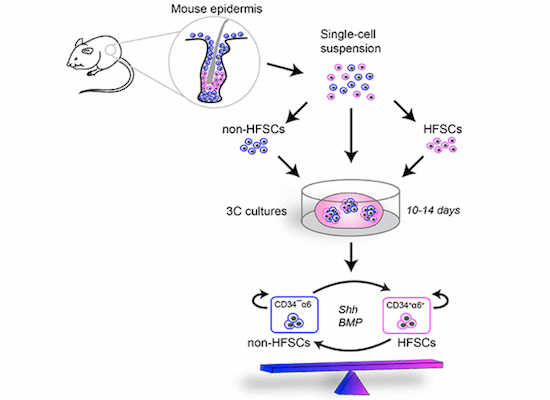- Reaction score
- 950
Hair follicle stem cell cultures reveal self‐organizing plasticity of stem cells and their progeny
Carlos Andrés Chacón‐Martínez, Markus Klose, Catherin Niemann, Ingmar Glauche, Sara A Wickström
Published online 09.12.2016


Carlos Andrés Chacón‐Martínez, Markus Klose, Catherin Niemann, Ingmar Glauche, Sara A Wickström
Published online 09.12.2016
Understanding how complex tissues are formed, maintained, and regenerated through local growth, differentiation, and remodeling requires knowledge on how single‐cell behaviors are coordinated on the population level. The self‐renewing hair follicle, maintained by a distinct stem cell population, represents an excellent paradigm to address this question. A major obstacle in mechanistic understanding of hair follicle stem cell (HFSC) regulation has been the lack of a culture system that recapitulates HFSC behavior while allowing their precise monitoring and manipulation. Here, we establish an in vitro culture system based on a 3D extracellular matrix environment and defined soluble factors, which for the first time allows expansion and long‐term maintenance of murine multipotent HFSCs in the absence of heterologous cell types. Strikingly, this scheme promotes de novo generation of HFSCs from non‐HFSCs and vice versa in a dynamic self‐organizing process. This bidirectional interconversion of HFSCs and their progeny drives the system into a population equilibrium state. Our study uncovers regulatory dynamics by which phenotypic plasticity of cells drives population‐level homeostasis within a niche, and provides a discovery tool for studies on adult stem cell fate.

An advanced in vitro culture system allows for enrichment and long‐term maintenance of multipotent mouse hair follicle stem cells (HFSCs), recapitulating key features of their in vivo regulation.
- Combination of a 3D extracellular matrix environment and defined soluble components (FGF‐2, VEGF‐A, ROCK inhibitor Y27632) facilitates long‐term propagation of HFSCs.
- HFSC expansion can be achieved from purified HFSCs as well as from total or HFSC‐depleted epidermal cell mixtures.
- Cultured HFSCs retain multipotency, self‐renewal potential, and transcriptional identity.
- Bidirectional interconversion of cultured HFSCs driven by BMP and Shh pathways leads to self‐organization into a dynamic equilibrium between HFSCs and their progeny.
